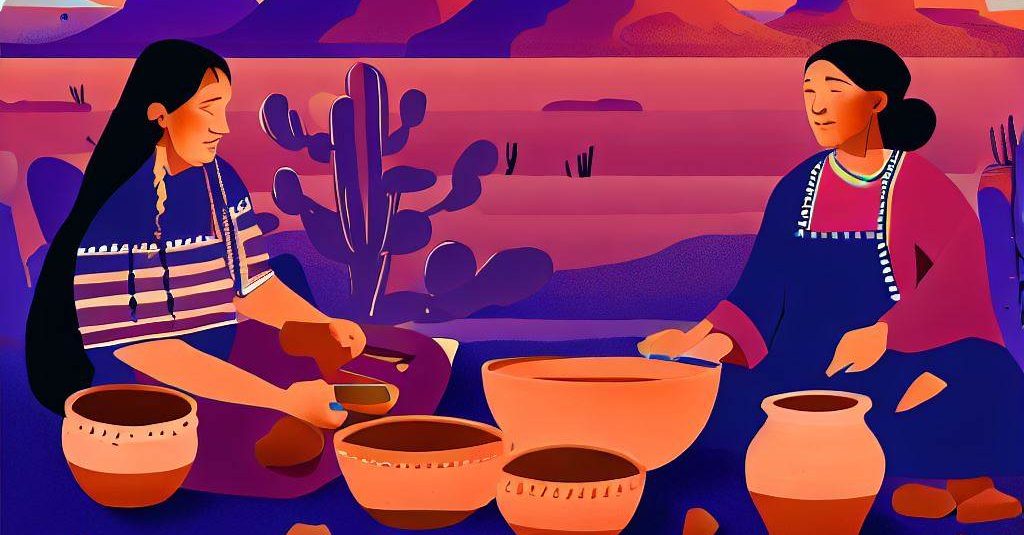Navajo Pottery: A Journey Through Time, Tradition, and Intertribal Influence
Navajo pottery is an essential aspect of the tribe’s rich artistic heritage, reflecting a unique blend of tradition, innovation, and cultural exchange. This ancient art form has undergone significant changes over time, adapting to external influences and internal developments within the Navajo community. This article will explore the origins, techniques, and evolution of Navajo pottery, highlighting the interactions with other tribes and peoples that have shaped this dynamic art form. By understanding the multifaceted history of Navajo pottery, we can foster a greater appreciation for the interconnected histories, cultures, and experiences of Native American peoples.
The Origins of Navajo Pottery:
The Navajo people are believed to have learned pottery-making techniques from the Pueblo tribes, particularly the Hopi and Zuni, who had a long-established tradition of pottery production. Archaeological evidence suggests that the Navajo began creating pottery around the 16th century, incorporating Puebloan designs and techniques into their early work. These early Navajo ceramics were primarily utilitarian, created for everyday use in cooking, storage, and transport of food and water.
Over time, the Navajo developed their distinctive style, incorporating traditional Navajo symbols, patterns, and colors into their pottery. This unique aesthetic reflected the tribe’s spiritual beliefs, history, and worldview, setting Navajo pottery apart from the work of other tribes in the region.
Techniques and Materials:
Navajo pottery is traditionally made using a coiling technique, in which long, thin ropes of clay are rolled out and then coiled upon one another to form the desired shape. The vessel is then smoothed and shaped using a scraper or wooden paddle, often made from gourds or corn cobs. The pottery is then left to dry before being fired in a traditional open-air pit or underground kiln.
Navajo potters typically use locally sourced clay, which they clean and prepare by hand. The clay’s color and texture can vary depending on the specific location, allowing for a diverse range of pottery styles and finishes. Natural pigments, such as iron oxide and vegetal dyes, are used to create the vibrant colors and designs seen in Navajo pottery.
Navajo Pottery Techniques and Materials
Types of Navajo Pottery:
Navajo pottery encompasses a wide range of styles and forms, reflecting the diverse influences and traditions that have shaped the art form over time. Some notable types of Navajo pottery include:
Utilitarian Pottery:
These early examples of Navajo pottery were created for functional purposes, such as cooking and storage. They often feature simple, undecorated designs and sturdy construction, reflecting their practical use in daily life.
Decorative Pottery:
As Navajo potters developed their unique aesthetic, they began to create more elaborate and ornate pieces intended for ceremonial and decorative purposes. These pots often feature intricate geometric patterns, stylized animal and plant motifs, and vibrant colors, showcasing the skill and creativity of Navajo artists.
Storyteller Pottery:
A more recent development in Navajo pottery, storyteller pots depict scenes or narratives from Navajo history, mythology, or daily life. These pieces often feature detailed, sculpted figures and elements, allowing the artist to convey a story or message through their work.
Contemporary Pottery:
Many Navajo potters today continue to explore new techniques, materials, and designs, pushing the boundaries of traditional pottery while maintaining a strong connection to their cultural heritage. Contemporary Navajo pottery often combines traditional elements with innovative forms and finishes, reflecting the dynamic nature of the art form.
Intertribal Connections and the Evolution of Navajo Pottery:
Navajo pottery has been shaped by interactions with other tribes and peoples throughout its history. The initial influence of Puebloan pottery techniques and designs laid the foundation for the development of Navajo pottery, while the introduction of new materials and artistic styles from other tribes, such as the Apache and Ute, contributed to the evolution and diversification of Navajo pottery styles.
In addition to intertribal connections, Navajo pottery has been influenced by non-Native market demands and artistic trends. As a result, Navajo potters have adapted their work to cater to collectors and enthusiasts, incorporating new techniques and designs while maintaining a deep respect for their cultural heritage.
The Significance of Navajo Pottery in Contemporary Navajo Culture:
Navajo pottery remains an essential aspect of Navajo culture, providing a tangible connection to the tribe’s history, spirituality, and identity. Pottery-making is often passed down through generations, with elders teaching younger members the techniques, designs, and cultural significance of the craft. This intergenerational transmission of knowledge and skills helps preserve the tribe’s traditions and reinforces their sense of cultural identity.
Today, Navajo pottery is a vibrant and diverse art form, with many contemporary potters experimenting with new materials, designs, and techniques while maintaining a deep respect for the tradition’s roots. Navajo ceramics are sought after by collectors and enthusiasts worldwide, reflecting the global appreciation for the tribe’s unique artistic heritage.
Conclusion:
Navajo pottery is a complex and diverse art form that embodies the tribe’s cultural values, history, and spiritual beliefs. The origins, techniques, and evolution of Navajo pottery have been shaped by interactions with other tribes and peoples, illustrating the interconnectedness of Native American experiences. By understanding and appreciating the rich history of Navajo pottery, we can foster a greater understanding of the Navajo people and their unique contributions to the world of art and culture.
Sources Consulted:
- James, H.L., and Navajo Arts and Crafts Enterprise. “Navajo Pottery.” Navajo Arts and Crafts Enterprise, 1991.
- Schaaf, Gregory. “Pueblo Indian Pottery: 750 Artist Biographies.” CIAC Press, 2000.
- Trimble, Stephen. “Talking with the Clay: The Art of Pueblo Pottery.” School of American Research Press, 1987.
- Van Valkenburgh, Richard F., and John A. Breen. “Navajo Pottery and Ethnology.” Museum of Northern Arizona, 1974.
- Wyckoff, Lydia L., editor. “Visions and Voices: Native American Painting from the Philbrook Museum of Art.” University of New Mexico Press, 1996.

